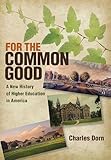For the Common Good : A New History of Higher Education in America / Charles Dorn.
Material type: TextSeries: American Institutions and SocietyPublisher: Ithaca, NY : Cornell University Press, [2017]Copyright date: ©2017Description: 1 online resource (324 p.) : 11 b&w photosContent type:
TextSeries: American Institutions and SocietyPublisher: Ithaca, NY : Cornell University Press, [2017]Copyright date: ©2017Description: 1 online resource (324 p.) : 11 b&w photosContent type: - 9781501712616
- Education, Higher -- United States -- History
- Universities and colleges -- United States -- History
- Education & History Of Education
- U.S. History
- EDUCATION / History
- higher education, colleges and the common good, higher education policy, history of universities, ethics and academia, American higher education, universities and public service, American universities, history of education
- 378.73 23
- LA226
- LA226 .D67 2018
- online - DeGruyter
| Item type | Current library | Call number | URL | Status | Notes | Barcode | |
|---|---|---|---|---|---|---|---|
 eBook
eBook
|
Biblioteca "Angelicum" Pont. Univ. S.Tommaso d'Aquino Nuvola online | online - DeGruyter (Browse shelf(Opens below)) | Online access | Not for loan (Accesso limitato) | Accesso per gli utenti autorizzati / Access for authorized users | (dgr)9781501712616 |
Frontmatter -- Contents -- Acknowledgments -- Prologue -- THE EARLY NATIONAL PERIOD -- 1. “Literary Institutions Are Founded and Endowed for the Common Good” -- 2. “The Good Order and the Harmony of the Whole Community” -- 3. “To Promote More Effectually the Grand Interests of Society” -- THE ANTEBELLUM AND CIVIL WAR ERAS -- 4. “To Spread Throughout the Land, an Army of Practical Men” -- 5. “The Instruction Necessary to the Practical Duties of the Profession” -- RECONSTRUCTION THROUGH THE SECOND WORLD WAR -- 6. “To Qualify Its Students for Personal Success” -- 7. “This Is to Be Our Profession—To Serve the World” -- 8. “The Burden of His Ambition Is to Achieve a Distinguished Career” -- THE COLD WAR THROUGH THE TWENTY-FIRST CENTURY -- 9. “A Wedding Ceremony between Industry and the University” -- 10. “To Meet the Training and Retraining Needs of Established Business” -- Epilogue -- Notes -- Selected Bibliography -- Index
restricted access online access with authorization star
http://purl.org/coar/access_right/c_16ec
Are colleges and universities in a period of unprecedented disruption? Is a bachelor's degree still worth the investment? Are the humanities coming to an end? What, exactly, is higher education good for?In For the Common Good, Charles Dorn challenges the rhetoric of America's so-called crisis in higher education by investigating two centuries of college and university history. From the community college to the elite research university—in states from California to Maine—Dorn engages a fundamental question confronted by higher education institutions ever since the nation's founding: Do colleges and universities contribute to the common good?Tracking changes in the prevailing social ethos between the late eighteenth and early twenty-first centuries, Dorn illustrates the ways in which civic-mindedness, practicality, commercialism, and affluence influenced higher education's dedication to the public good. Each ethos, long a part of American history and tradition, came to predominate over the others during one of the four chronological periods examined in the book, informing the character of institutional debates and telling the definitive story of its time. For the Common Good demonstrates how two hundred years of political, economic, and social change prompted transformation among colleges and universities—including the establishment of entirely new kinds of institutions—and refashioned higher education in the United States over time in essential and often vibrant ways.
Mode of access: Internet via World Wide Web.
In English.
Description based on online resource; title from PDF title page (publisher's Web site, viewed 26. Apr 2024)


